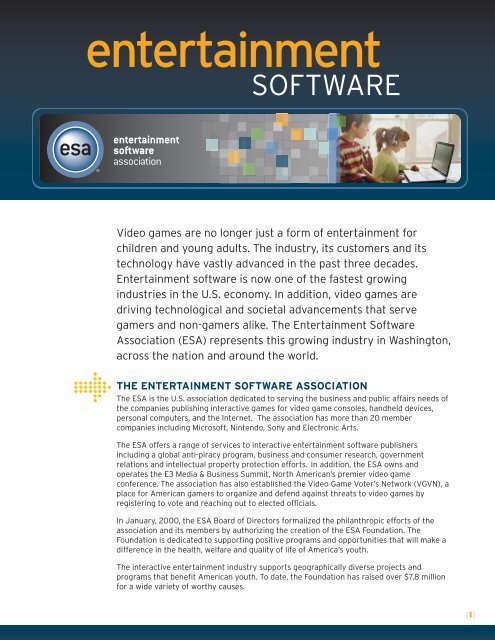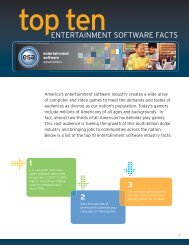Entertainment Software Fact Sheet
Entertainment Software Fact Sheet
Entertainment Software Fact Sheet
Create successful ePaper yourself
Turn your PDF publications into a flip-book with our unique Google optimized e-Paper software.
entertainment<br />
SOFTWARE<br />
Video games are no longer just a form of entertainment for<br />
children and young adults. The industry, its customers and its<br />
technology have vastly advanced in the past three decades.<br />
<strong>Entertainment</strong> software is now one of the fastest growing<br />
industries in the U.S. economy. In addition, video games are<br />
driving technological and societal advancements that serve<br />
gamers and non-gamers alike. The <strong>Entertainment</strong> <strong>Software</strong><br />
Association (ESA) represents this growing industry in Washington,<br />
across the nation and around the world.<br />
THE ENTERTAINMENT SOFTWARE ASSOCIATION<br />
The ESA is the U.S. association dedicated to serving the business and public affairs needs of<br />
the companies publishing interactive games for video game consoles, handheld devices,<br />
personal computers, and the Internet. The association has more than 20 member<br />
companies including Microsoft, Nintendo, Sony and Electronic Arts.<br />
The ESA offers a range of services to interactive entertainment software publishers<br />
including a global anti-piracy program, business and consumer research, government<br />
relations and intellectual property protection efforts. In addition, the ESA owns and<br />
operates the E3 Media & Business Summit, North American’s premier video game<br />
conference. The association has also established the Video Game Voter’s Network (VGVN), a<br />
place for American gamers to organize and defend against threats to video games by<br />
registering to vote and reaching out to elected officials.<br />
In January, 2000, the ESA Board of Directors formalized the philanthropic efforts of the<br />
association and its members by authorizing the creation of the ESA Foundation. The<br />
Foundation is dedicated to supporting positive programs and opportunities that will make a<br />
difference in the health, welfare and quality of life of America’s youth.<br />
The interactive entertainment industry supports geographically diverse projects and<br />
programs that benefit American youth. To date, the Foundation has raised over $7.8 million<br />
for a wide variety of worthy causes.<br />
[1]
ECONOMIC IMPACTS AND GAME SALES<br />
Conducted by Economists Incorporated, “Video Games in the 21st Century: Economic<br />
Contributions of the U.S. <strong>Entertainment</strong> <strong>Software</strong> Industry” quantifies in detail the specific<br />
contributions of the U.S. entertainment software industry to the nation’s economy. The<br />
study found:<br />
● From 2003 to 2006, the entertainment software industry’s annual growth rate<br />
exceeded 17 percent. Over the same period, the entire U.S. economy grew at a less<br />
than four percent rate.<br />
● The industry’s contribution to U.S. Gross Domestic Product (GDP) was $3.8 billion<br />
in 2006.<br />
● For the four-year period 2002 through 2006, direct employment for the industry<br />
grew at an annual rate of 4.4 percent. Currently, computer and video game<br />
companies directly and indirectly employ more than 80,000 people in 31 states.<br />
Data compiled by the NPD Group, a global market research company, showed that the<br />
computer and video game companies posted record sales of 267.8 million units in 2007<br />
which led to $9.5 billion in revenue. On average, nine games were sold every second of every<br />
day of 2007. NPD’s research also revealed:<br />
● <strong>Software</strong> made for game consoles led the industry’s sales in 2007 with 153.9 million<br />
units sold and total revenue of $6.6 billion.<br />
● The genre with the greatest growth was “Family <strong>Entertainment</strong>.” Family games<br />
accounted to 17.2 percent of all games sold in 2007, more than one of every six<br />
games sold, up from 9.1 percent in 2006. In addition, only 15 percent of games sold<br />
last year were rated “Mature (M).”<br />
● Halo 3®, the best-selling title of 2007, took in more revenue in its first day of sales<br />
than the biggest opening weekend ever for a movie (“Spider-Man 3”) and the final<br />
“Harry Potter” book’s first day sales.<br />
TODAY’S GAMER<br />
The ESA’s “2008 Essential <strong>Fact</strong>s about the Computer and Video Game Industry” showed<br />
that today’s average gamer is 35 years old and has been playing for 13 years. This annual<br />
research study has also revealed:<br />
● Sixty-five percent of American households play computer and video games. Thirtyeight<br />
percent of American homes have a video game console and 41 percent of<br />
Americans expect to purchase one or more games this year.<br />
● Forty percent of all players are women. In fact, women age 18 or older represent a<br />
significantly greater portion of the game-playing population (33 percent) than boys<br />
age 17 or younger (18 percent).<br />
● One out of four game players are over the age of 50, a figure sure to rise in coming<br />
years with nursing homes and senior centers across the nation now incorporating<br />
video games into their activities.<br />
[2]
RESOURCES FOR PARENTS<br />
The ESA’s 2008 Essential <strong>Fact</strong>s study found that 88 percent of parents report that they<br />
monitor the content of the games their children are playing and are present 94 percent of<br />
the time games are purchased or rented. The ESA is working to help parents make sure that<br />
children are safe online and playing video games their parents consider appropriate.<br />
Through the <strong>Entertainment</strong> <strong>Software</strong> Rating Board (ESRB) the association has voluntarily<br />
established numerous tools and policies to help parents make educated choices and to<br />
encourage retailers to sell age-appropriate games to youngsters. The latest report of the<br />
Federal Trade Commission shows that over 80 percent of parents are aware of these ratings<br />
system and over 70 percent of parents use the system in making their buying decisions.<br />
The association also promotes parental controls included in many of today’s game consoles.<br />
These devices allow parents to block games and movies they don’t want their children to<br />
view and limit the amount of time kids spend on video games.<br />
The ESA is also a major supporter of the Web Wise Kids’ Program, which is working to keep<br />
children safe in today’s technology rich environment. This unique organization that teaches<br />
kids about essential safety and privacy issues – such as social networking, blogging, online<br />
romances, bullying, cyber stalking, and identify theft – through fun, challenging, and<br />
interactive simulations that are based on actual criminal cases.<br />
GAMES IN DAILY LIFE<br />
More than just play, the entertainment software industry has spurred the introduction of<br />
faster personal computers; more realistic military training methods; and new tools for<br />
educating our children. Below are just a few examples of how the video and computer game<br />
industry is helping Americans lead healthier, happier and more productive lives:<br />
● Health Care: Video games are being used to advance healthcare, both through<br />
patient care and medical professional training. “Re-mission,” a video game created<br />
by Hope Labs teaches child cancer patients about how the disease and its<br />
treatments are affecting their bodies. The Office of Naval Research has developed<br />
a simulation based on video game technology to train nurses. In addition, games<br />
are now being looked at as a source of physical fitness and rehabilitation.<br />
● The Workplace: Research conducted by the ESA shows that 7 out of 10 businesses<br />
are using interactive computer training that could include video games to train<br />
their employees. A wide range of businesses are using video games for<br />
recruitment and training. The MITRE Corporation has developed a video game<br />
called “Job of Honor” to create awareness of the company and recruit employees.<br />
One entertainment software company, Game 2Train, has developed employee<br />
training games for American Express, Bank of American, IBM, JP Morgan Chase,<br />
Nokia and Pfizer. Canon uses a video game where repairmen must drag and drop<br />
parts into the right spot on a copier to train technicians.<br />
● Education: Educators are harnessing the power of video games for learning. In<br />
addition to being a great way to keep kids engaged, researchers have found that<br />
video games have real potential as next generation learning tools which incorporate<br />
principles crucial to human cognitive learning. The National Education Association<br />
(NEA) has produced resources designed to help teachers incorporate video games<br />
into their lesson plans. NEA recommends building games, such as <strong>Entertainment</strong><br />
Art’s “Sim City” to improve student’s problem-solving and analytical skills.<br />
● Art: <strong>Entertainment</strong> software is gaining credit as an art form on its own and through<br />
partnerships with the film and music industries. “Into the Pixel” is an international<br />
exhibit of video game art, which offers an opportunity for published game artists to<br />
[3]
e reviewed and recognized. “Video Games Live” is a concert tour featuring video<br />
game music performed by top orchestras and choirs.<br />
● Defense and Homeland Security: Video games are playing a role in the Global War<br />
on Terror. The U.S. Army uses Virtual Training Technology to enable soldiers from<br />
distant locations to train together on missions that require group coordination.<br />
Carnegie Mellon University has developed a video game to prepare police and fire<br />
departments for terrorist attacks involving biological or chemical hazards.<br />
● Social Issues: Nonprofit organizations and issue advocates now view video games<br />
as an effective medium for communicating ideas and generating support among<br />
young tech savvy consumers. “Food Force,” was created by the United Nations<br />
World Food Programme to educate children about world hunger. While the<br />
Independent Television Service released an online game in May 2007 called “World<br />
Without Oil,” that invited players to participate in a collaborative simulation of a<br />
global oil shortage.<br />
INTELLECTUAL PROPERTY AND PIRACY<br />
Because releases of game software titles have relatively short commercial shelf lives, game<br />
piracy can have a particularly pernicious effect on the sales performance of many games.<br />
Casual infringements, which consist of otherwise law-abiding people downloading pirate<br />
versions of games through the Internet, is exacting a greater toll on the industry than it<br />
used to. As a result, the ESA is attacking game piracy not only with enforcement but also<br />
through education. The entertainment software industry is a leader in promoting the<br />
adoption of an IP education curriculum for use in elementary schools to teach children<br />
about the importance of intellectual property as a source of creativity and innovation<br />
deserving of respect and protection.<br />
The high rates of piracy in many countries abroad have prevented many game publishers<br />
from entering those markets and establishing legitimate markets for their game products.<br />
The ESA is very supportive of U.S. government efforts to use trade pressure to get those<br />
countries to enforce their IP laws and reduce the level of piracy so that legitimate game<br />
products have a chance to compete in these foreign market places.<br />
[4]
















